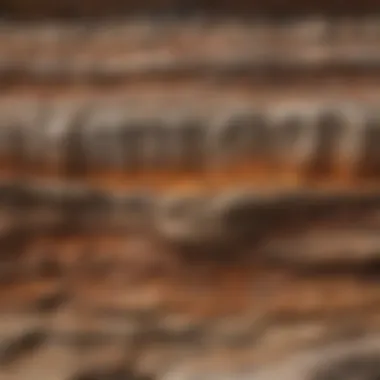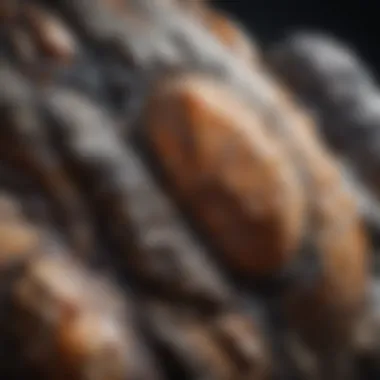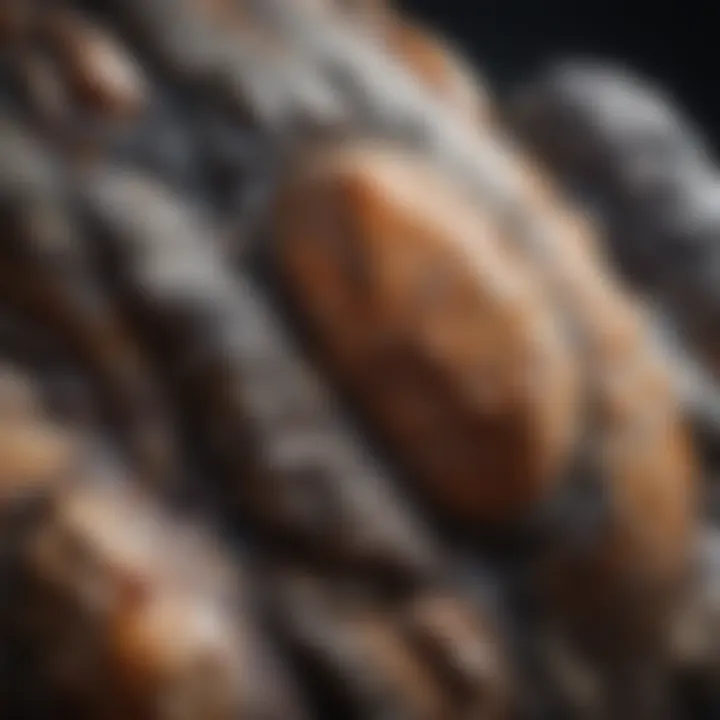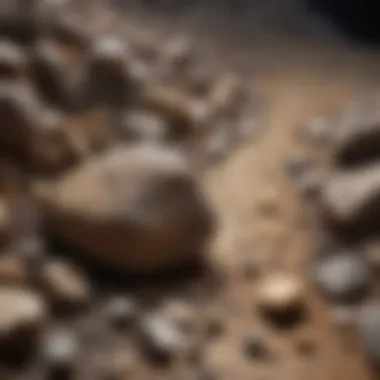Exploring the Diverse Types of Rocks: A Comprehensive Guide


Intro
Rocks are not just pebbles you find on the ground or the materials in your driveway. They are much more complex, telling stories of our Earth’s history and evolution. Understanding the three main types of rocks—igneous, sedimentary, and metamorphic—opens a door to a captivating world. Each type has its own unique characteristics, formation processes, and roles in both nature and human culture. For rock collectors and enthusiasts, recognizing these distinctions is crucial, not just for appreciation but also for the practicalities of collection and study.
This exploration will take you through the essence of each rock type, examining how they form and what makes them unique. Moreover, we’ll cover identification techniques that are essential for collectors aiming to distinguish between these varieties. So, whether you're casually collecting or diving deep into the geological sciences, this guide should enhance your understanding and appreciation of the magnificent world of rocks.
Featured Collectible of the Month
Overview
This month, we spotlight the Igneous Rock Obsidian. Known for its glossy black surface and sharp edges, obsidian is formed from rapidly cooled lava. This fascinating volcanic glass not only makes for a striking collectible but also has a deep connection to human history, often used by ancient civilizations for tools and weaponry.
Historical Significance
Obsidian's historical use dates back thousands of years, with archaeological finds revealing its use in the production of arrowheads and knives. The sharpness of obsidian allows for precise cuts, making it invaluable in both everyday utilization and ceremonial practices. Today, its allure continues, drawing collectors and enthusiasts who seek to understand its beauty and significance.
"Rocks may seem inert, but they hold the narratives of time itself."
Identification Techniques
Visual Characteristics
When attempting to identify rocks, keen observation is your best friend. Here are some key visual characteristics to keep in mind:
- Color: Different rock types showcase various colors. Obsidian, for instance, is typically black but can also present mixed hues.
- Texture: The smooth surface of obsidian contrasts sharply with the grainy texture of sedimentary rocks like sandstone.
- Composition: Look for unique features, such as the tiny bubbles in pumice or the layered appearance of shale.
Resources for Identification
Finding reliable information can be a game changer for a collector. Here are a few valuable resources:
- Wikipedia
- Britannica
- Online communities like Reddit provide a platform for collectors to ask questions and share discoveries.
- Social media groups on Facebook focus on local rock hunting and trading.
By employing these techniques and resources, collectors can enhance their skills in identifying and understanding different rock types, paving the way for deeper exploration and appreciation.
Preamble to Rocks
Understanding rocks is a gateway to unraveling the intricate stories held within the Earth’s crust. Rocks weave the narrative of our planet, capturing its changes over millions of years. Each rock embodies unique characteristics, thus becoming a crucial subject of study not just for geologists, but also for collectors, artists, and anyone fascinated by the natural world. In this article, we will explore the various types of rocks, highlighting their formation processes, features, and significance.
Definition of Rocks
Rocks are naturally occurring solid aggregates composed of one or more minerals or mineraloids. To grasp the definition better, imagine a simple granite countertop. Granite is a rock made up of quartz, feldspar, and mica, coming together to form a durable surface. Rocks display immense variety in terms of texture, color, and composition.
To categorize rocks effectively, we typically classify them into three main types: igneous, sedimentary, and metamorphic. This classification does not just serve as academic jargon; it provides a means to understand how rocks form, change, and relate to one another in the greater context of geological processes.
The Importance of Studying Rocks
Studying rocks goes beyond mere academic interest. It has profound implications. Here are a few reasons why this subject is significant:
- Understanding Earth’s History: Rocks hold clues about our planet’s past, including tectonic movements, climate conditions, and ancient life forms.
- Resource Extraction: Many rocks are reservoirs of vital natural resources, from metals to fossil fuels, making the study of rocks economically important.
- Geological Hazards: Insight into rock types can help predict geological hazards such as landslides or earthquakes, enhancing safety in populated areas.
- Ecological Role: Different rocks contribute to soil formation and support various ecosystems, which is essential for biodiversity.
"Rocks are the witnesses of time – they speak volumes about the processes that shaped our planet."
Classification of Rocks
Understanding how rocks are classified is fundamental to the study of geology. This classification not only enhances our knowledge about their origin and structure but also provides crucial insight for enthusiasts and collectors. By recognizing the unique characteristics of different rock types, collectors can discern the various textures and minerals present, fostering a deeper connection to their geological finds.
When we talk about classifying rocks, we typically refer to three main categories: igneous, sedimentary, and metamorphic. Each type tells its own story about the Earth's processes. Knowing these distinctions aids in appreciating the history locked within each specimen. Furthermore, this classification helps scientists and enthusiasts alike to discuss rocks more effectively, allowing for a shared vocabulary when it comes to features such as color, grain size, and formation patterns.
The Three Main Types of Rocks
Rocks can be broadly categorized into three types, each having its own formation process and textural characteristics.
- Igneous Rocks: Formed from the cooling and solidification of molten rock, these can be classified into two categories:
- Sedimentary Rocks: These rocks develop from the accumulation and compaction of mineral and organic debris. There are several categories:
- Metamorphic Rocks: These arise from existing rocks subjected to heat and pressure, altering their mineral composition and structure. In this category:
- Intrusive Igneous Rocks: These form underground when magma cools slowly, resulting in coarse grains. An example is granite, known for its hardness and variety of colors.
- Extrusive Igneous Rocks: Created when lava cools quickly on the surface, producing fine-grained textures. Basalt exemplifies this category, often found in volcanic regions.
- Clastic Sedimentary Rocks: Composed of fragments of other rocks, such as sandstone.
- Chemical Sedimentary Rocks: Formed from the precipitation of minerals from water, like limestone.
- Biological Sedimentary Rocks: Comprised of materials from living organisms, such as coal.
- Foliated Metamorphic Rocks: Characterized by layered texture. Schist is a prominent example.
- Non-Foliated Metamorphic Rocks: Lacking a banded appearance, with marble being a classic representation.
Each of these rock types carrying distinctive features invites collectors to learn more about their origin and significance within the Earth’s context. Recognizing their respective categories enables enthusiasts to enhance both their collection and understanding of geological narratives.
"Rocks are the historical records of our planet, a testament to its ever-changing nature."
In summary, classifying rocks not only aids collectors in organizing their precious finds but also enhances the broader understanding of geological processes. With each rock type reflecting the intricate history of Earth, this classification serves as a bridge between science and appreciation, creating a space where the beauty of nature can truly shine.
Igneous Rocks
Igneous rocks form a cornerstone in the study of geology, offering intriguing insights into the Earth's inner workings. They arise from the solidification of molten rock, a process that reveals much about the conditions deep within the Earth. Understanding igneous rocks is vital not just for geologists but also for collectors and enthusiasts who wish to appreciate the tales these stones tell of their fiery origins.
Formation Processes
The formation of igneous rocks is a two-fold affair: either they form from magma beneath the Earth's surface, or they erupt onto the surface as lava. When magma cools slowly underground, it crystallizes into what we call intrusive igneous rocks. On the flipside, when lava reaches the surface and cools rapidly, it forms extrusive igneous rocks. Each process not only affects the texture and mineral composition of the rocks but also shapes their broader geological context.
Major Types of Igneous Rocks


Intrusive Igneous Rocks
Intrusive igneous rocks, also known as plutonic rocks, crystallize slowly, allowing larger crystals to form. This slow cooling occurs deep underground, where heat is trapped, such as in magma chambers. Granite is the poster child of this category; it showcases a coarse-grained texture that's not only visually appealing but also practical. Because of its durability, granite often finds its way into countertops and building materials, making it a popular choice for architects and homeowners alike.
The slow cooling allows for larger mineral crystals to form, which is a signature feature of intrusive igneous rocks.
One notable disadvantage could be that mining these rocks can be more challenging given their depth below the surface. However, the aesthetic appeal and physical properties often outweigh these challenges.
Extrusive Igneous Rocks
Conversely, extrusive igneous rocks like basalt form when volcanic lava cools quickly upon exposure to the atmosphere. This rapid cooling creates a fine-grained texture, which can sometimes go unnoticed without proper inspection. A key characteristic of basalt is its density; it packs quite a punch despite its lightweight feel. Its unique feature is that it often has vesicles, or gas bubbles, which can leave alluring patterns in the rock.
This type is prevalent in places like Hawaii, known for its stunning volcanic landscapes. One of the downsides of basalt is its tendency to weather quicker than its intrusive counterparts, but its beauty and the rich soil it helps create make it priceless as a resource in nature.
Common Examples
Granite
Granite stands as one of the most recognized intrusive igneous rocks. Its mixtures of quartz, feldspar, and mica create a speckled appearance that many find captivating. Beyond its beauty, this rock is exceptionally robust and heat-resistant, making it suitable for diverse applications such as flooring and monuments. But working with granite can be tricky; its durability requires specialized tools to shape and polish.
Basalt
Basalt, on the other hand, is the most common volcanic rock on Earth. It's found in oceans and on land alike, dominating the landscape. Its high iron and magnesium content lend it a darker appearance and contribute to its density and durability. Despite being less flashy than granite, basalt has been historically significant in construction, forming solid foundations and bricks.
Identification Techniques for Igneous Rocks
Identifying igneous rocks can involve looking at several factors like texture, color, and mineral composition. Examining the crystal size offers a clue; larger crystals often point to intrusive origins while finer grains hint at extrusive formation. Tools such as magnifying glasses can allow enthusiasts to scrutinize textures and structures in greater detail. Furthermore, simple tests on hardness or reaction to acid can separate one type from another, ensuring collectors know precisely what they hold in their hands.
Sedimentary Rocks
Sedimentary rocks hold a distinct place in the broader classification of rocks, offering insights that are both fascinating and essential to understanding geological processes. These rocks form through the accumulation and consolidation of sediment, making their study crucial for anyone interested in geology, environmental science, or ecology. Their layered structures tell stories of past environments, depositional processes, and even ancient life. In the context of this article, examining sedimentary rocks allows us to grasp how they contribute to the rock cycle and influence landscapes.
Formation Mechanisms
Sedimentary rocks arise from several formation mechanisms, primarily involving the processes of weathering, erosion, deposition, and lithification. Weathering breaks down existing rocks into sediments, while erosion transports these particles to new locations, often settling in riverbeds, lakes, or ocean floors. Over time, accumulated sediments undergo compaction and cementation, transforming them into solid rock.
"The path of a sedimentary rock, from particles suspended in water to solid stone, reflects an intricate interplay of natural forces."
Categories of Sedimentary Rocks
Sedimentary rocks can be broadly categorized into three main types, each with its unique formation process, characteristics, and significance:
Clastic Sedimentary Rocks
Clastic sedimentary rocks are composed of fragments from pre-existing rocks, showcasing the results of mechanical weathering. The primary characteristic is their grain size, which can range from fine clay to coarse gravel. This specific aspect makes them a popular focus for enthusiasts.
A unique feature of clastic rocks is their stratification, a dominant trait that illustrates the conditions under which they formed. While they provide invaluable records of geological history, clastic rocks can also be susceptible to erosion, which poses a disadvantage for their preservation.
Chemical Sedimentary Rocks
Chemical sedimentary rocks originate from the precipitation of minerals from solution, often found in environments like lakes and oceans. Their key characteristic is their crystalline structure, typically forming intricate patterns and textures. This type of rock contributes significantly to the geological narrative, as they often indicate the chemical conditions of the environment where they formed.
For instance, evaporites, a subtype of chemical rocks such as rock salt, exemplify a mineral left behind after water evaporates. This leads to impressive formations, though some can more easily weather compared to their clastic counterparts.
Biological Sedimentary Rocks
Biological sedimentary rocks, also known as biogenic rocks, form from the remains of living organisms, which can include plant life and shell fragments. The key characteristic here is the presence of organic material, often visible in their texture. These rocks, such as coal and some limestone, provide significant insights into past ecosystems and the life forms that once inhabited them.
The unique feature of biological rocks is their ability to preserve fossils, offering clues about ancient life. However, they can be sensitive to environmental changes, making their study integral for understanding biodiversity over time.
Notable Examples
In exploring sedimentary rocks, a couple of examples stand out prominently in both geological significance and ease of identification.
Sandstone
Sandstone represents one of the most abundant sedimentary rocks, primarily formed from sand-sized minerals or rock grains. Its notable characteristic is its granularity and a diverse range of colors, typically influenced by the mineral composition. Sandstone's durability makes it beneficial for various uses, from construction to artistic endeavors like sculpture.
However, sandstone can be porous, which may allow for liquid penetration, posing a disadvantage in specific applications where waterproofing is vital.
Limestone
Limestone is another vital sedimentary rock, composed mainly of calcium carbonate. Its significance lies in its formation from biological processes, mainly the accumulation of shell fragments and coral. The key characteristic of limestone is its effervescence in acid, a helpful identification feature.
Limestone serves numerous purposes, including as a crucial ingredient in cement production and as a soil conditioner. However, its susceptibility to acid rain can compromise its structural integrity over time, raising concerns about preservation in urban settings.
Identifying Sedimentary Rocks
Identifying sedimentary rocks involves careful observation of certain physical characteristics, such as grain size, color, and texture. Tools like hand lenses and pH test kits can assist enthusiasts in understanding the rock’s chemical properties. To enhance skills, considering field guides can provide additional insights, thereby enriching the collecting experience for rock aficionados.
Metamorphic Rocks
Metamorphic rocks play a significant role in understanding the earth’s geological evolution. They are born from the transformation of existing rocks—igneous, sedimentary, or seemingly other metamorphic types—exposed to substantial pressure, high temperature, or chemically active fluids. These processes, deep within the Earth's crust, reshape the mineral structure without melting the rock entirely. This characteristic makes metamorphic rocks unique, classified mostly by their mineral composition and texture.
The Metamorphic Process
The metamorphic process involves several stages that dictate the formation and characteristics of metamorphic rocks. It typically begins when pre-existing rocks, undergoing some form of stress, slowly transition under conditions of elevated pressure and temperature. This change is not instantaneous but rather gradual, allowing for the realignment of minerals and the formation of new compounds. The parent rock, or the original rock, dictates the final metamorphic rock's features. For instance, limestone, when subjected to heat and pressure, transforms into marble, while shale changes into schist.


Types of Metamorphic Rocks
Metamorphic rocks can be broadly categorized into two primary types: foliated and non-foliated. Each type has distinct characteristics that contribute to their formation and overall geological significance.
Foliated Metamorphic Rocks
Foliated metamorphic rocks, as the name suggests, exhibit a layered or banded appearance due to the alignment of platy minerals under differential pressure. The key characteristic here is the foliation itself, which results from the pressure allowing minerals like mica or chlorite to form parallel alignments. This banding is not merely aesthetic; it adds strength to the rock, making it a robust material for construction—just think of slate, often used for roofing and flooring.
However, foliation can also be a disadvantage in certain applications, where uniform strength is needed. These layers can split along foliation planes, potentially limiting their use in scenarios demanding durability in all directions.
Non-Foliated Metamorphic Rocks
Unlike their foliated counterparts, non-foliated metamorphic rocks lack a layered appearance. They reflect a more uniform composition, where minerals are not aligned in any direction. This type arises primarily in conditions of uniform pressure, resulting in rocks such as marble and quartzite. The absence of foliation makes them versatile. Non-foliated rocks can be used widely in decorative applications, mainly marble, which is prized in sculpture and architecture for its aesthetic appeal.
However, they can be prone to scratching and wear, particularly in high-traffic areas. While they may look stunning, appropriate care and placements are essential to maintain their beauty.
Examples of Metamorphic Rocks
Understanding specific examples of metamorphic rocks can better illustrate their significance.
Schist
Schist is a popular metamorphic rock known for its shiny appearance due to plentiful mica crystals. This rock is often used in decorative applications like countertops and tiles given its unique texture. Schist’s rich mineral content, including garnet and biotite, adds to its visual appeal, making it a favored material in construction and art. It can, however, be challenging to work with due to its tendency to exfoliate along foliation planes.
Marble
Marble stands out as an iconic metamorphic rock, often associated with historical and modern architecture. Formed from limestone, marble possesses both beauty and durability. Its ability to take a high polish makes it ideal for statues, floors, and countertops. Its challenges include susceptibility to acids, which can etch the surface, yet its timeless appeal ensures it remains a symbol of luxury.
Identifying Metamorphic Rocks
Identification of metamorphic rocks relies on assessing mineral composition, texture, and foliation characteristics. Potential collectors and enthusiasts should look closely at both the visual aspects and the location of the rock formations. Common techniques include:
- Observe the texture: Look for any signs of banding or crystal alignment.
- Test for hardness: Use the Mohs scale to determine how hard or soft the rock is, which may provide clues about its composition.
- Examine mineral presence: Identify specific minerals that may give insights into the rock's parentage.
Remember: Identifying stones based on these characteristics can significantly deepen a collector's appreciation for their collection, revealing not only beauty but the geologic story behind each piece.
Geological Processes in Rock Formation
Understanding geological processes is crucial when delving into the world of rocks. These processes provide insight into how rocks are formed, transformed, and ultimately contribute to the earth's surface. Whether you are a seasoned collector or just starting your journey into geology, knowing these fundamentals helps you appreciate rocks in a new light.
Tectonic Activity
Tectonic activity is at the heart of rock formation. The Earth's lithosphere is divided into several plates that are constantly moving—some drifting apart, others crashing into each other. This movement shapes our planet's surface, creates mountains, and leads to the formation of rocks.
When tectonic plates shift, pressure builds up in the Earth's crust. This pressure can cause rocks to melt, leading to igneous formations when the molten material rises to the surface. In contrast, if two plates collide, the intense pressure can result in metamorphic rocks. For rock collectors, understanding tectonic activity can explain why certain regions are rich in specific rock types. For instance, areas near the Pacific Ring of Fire are known for their volcanic activity, presenting an opportunity to discover an array of igneous rocks.
Observing how landscapes change due to tectonic forces can enhance one's appreciation for geological diversity. Here are some points to consider:
- Mountain Ranges: Formed from the collision of tectonic plates.
- Volcanoes: Erupted through the cracks in Earth's surface.
- Earthquakes: Indicators of the dynamic nature of our planet.
Weathering and Erosion
Once rocks are formed, they are not static. Weathering and erosion are processes that break down rocks and transport material from one place to another. This influences sedimentary rock formation and shapes the landscapes we see today.
Weathering refers to the breakdown of rocks caused by environmental factors such as wind, water, and temperature changes. It can happen in several ways:
- Physical Weathering: Where rocks are broken down without changing their chemical composition.
- Chemical Weathering: Altering the minerals within the rock through chemical reactions.
- Biological Weathering: Living organisms, like lichens, break down rocks physically and chemically.
Erosion, on the other hand, involves the movement of those broken pieces. This could be through rainwater carrying sediments away or wind transporting sand particles. Together, these processes help in forming sedimentary rocks. For rock collectors, understanding these processes aids in identifying different types of rocks based on their origins.
Subjects of Study: Rock Cycle
The rock cycle is an ongoing series of processes that continually shapes and reshapes the Earth's crust. This cycle connects the three rock types—igneous, sedimentary, and metamorphic. It illustrates the interrelationships among these rocks and the dynamics of geological processes.
Here’s a simplified view of the rock cycle:
- Igneous Rocks form from cooled magma or lava.
- Weathering breaks these rocks down into sediments.
- Sedimentary Rocks form from the compaction and cementation of these sediments.
- Metamorphic Rocks are created when igneous or sedimentary rocks undergo heat and pressure.
- If conditions change, metamorphic rocks may weather down and restart the cycle.
The rock cycle is not just a concept; it's an active process that happens all around you. Knowledge of the rock cycle can greatly enhance your understanding of regional geology and inform your collecting strategies, focusing on areas where specific types of rocks are prevalent.
"The rock cycle emphasizes the interconnectedness of various geological processes. It shows that rocks are more than mere objects; they are part of a grand narrative of change and evolution."
In summary, geological processes are fundamental to understanding the diverse types of rocks. Tectonic activity, weathering and erosion, and the rock cycle all contribute to the dynamic nature of our Earth and influence the rocks we collect and study. Collecting rocks goes far beyond aesthetics—it's a journey through time and geological marvels.
The Role of Rocks in Ecosystems
Rocks are more than just inert materials scattered across the land; they are integral players in the delicate balance of ecosystems. The presence of rocks shapes the environment in many remarkable ways. Understanding their multifaceted role illuminates how life on Earth intertwines with geological processes.
Habitat and Biodiversity
Rocks provide unique habitats that host a plethora of life forms. In mountain ranges, outcrops act as home to various plants, insects, and larger animals. Lichens and mosses often colonize rocks, creating a microhabitat for other organisms. This initial colonization can lead to soil formation as organic material accumulates, making these areas more hospitable.
Furthermore, rocky environments offer protection from predators and harsh weather, allowing certain species to thrive. For example, rock crevices might house small mammals or reptiles, providing them a safe haven. The uneven surfaces and diverse shapes of rocks create different niches, fostering a range of biodiversity. Just think about how many different life forms take a liking to a simple boulder in the forest!
"In the rugged embrace of rocks, life finds a way to blossom in every nook and cranny."
Some organisms specifically evolved to rely on rocky substrates, such as certain algae in intertidal zones that cling to rocks amid shifting tides. These habitats can be hotspots of biodiversity, often supporting intricate food webs. Thus, rocks serve as essential foundations for ecological succession, contributing immensely to habitat complexity.


Soil Formation and Nutrient Cycling
Beyond providing habitat, rocks play a pivotal role in soil formation and nutrient cycling. When rocks weather—be it through physical breakdown or chemical processes—they contribute minerals essential for the growth of plants. This process is gradual but foundational, as it transforms solid rock into fertile soil. In areas with plentiful rainfall, the breakdown of granite, for instance, can enrich local soils with crucial nutrients like potassium and sodium.
Rock minerals, once incorporated into the soil, set the stage for robust nutrient cycling. Plants absorb these nutrients, which in turn support a wide array of life forms, from herbivores to apex predators. The interactions between rocks and biological elements create a living tapestry that sustains ecosystems.
In agriculture, understanding the rock composition of soils enhances practices as farmers tailor their approaches based on nutrient availability. Likewise, conservation efforts must consider the types of rocks in an area to maintain soil health and, by extension, biodiversity. The very ground under our feet tells a story of continuity and change, with rocks as silent yet powerful allies in the dance of life.
Rocks in Human Culture
Rocks are more than just solid entities formed over millennia. They represent a bridge between nature and human experience. Their physicality has been woven into the very fabric of our society, often embodying historical narratives and cultural milestones. Their significance stretches from ancient civilization all the way to modern-day life, shaping our culture, architecture, and even economies.
The study of rocks in human culture sheds light on how societal groups have interacted with their geological environment. This interaction tells a compelling story about resource utilization, spiritual beliefs, and artwork. Understanding this connection allows enthusiasts and collectors to appreciate not just the physical properties of rocks, but also their import in the social fabric through time.
Historical Significance
Throughout history, rocks have held substantial importance. In ancient days, human survival often depended on the availability of certain rock types. This is particularly true for flint, a rock used to create tools and weapons. The mastery of tool-making from flint marked a pivotal turn in human evolution, paving the way for our ancestors to thrive in various environments.
- Ancient Egyptians utilized limestone to construct monumental structures like the Pyramids, showcasing how geological materials can have enduring legacies.
- In the Americas, the indigenous peoples used obsidian, known for its sharp edges, to craft implements that facilitated hunting and daily tasks.
- Additionally, the use of granite in temples demonstrates how certain rocks tied into spiritual beliefs, as they were deemed strong and everlasting, signifying stability.
Rocks have also played crucial roles in marking landmarks and cultural identities, earning spots in both folklore and historical narratives. For instance, the Stonehenge in England remains a mystery and an icon of prehistoric societies, enveloped in myth and wonder.
Cultural Techniques in Rock Uses
Over time, different cultures have developed unique techniques to harness the benefits of rocks. The simplicity of using stones for basic tools evolved into intricate forms of artistry and functionality. Here’s a look at some of the methods employed across various cultures:
- Carving and Sculpting: Across the ages, cultures have carved rocks into statues and monuments. The meticulous craft of stone carving seen in Italian marble statues is an excellent example of art coming alive from a rock.
- Building Materials: Many societies have relied on rocks for construction. From brick made of clay and stone mix to finely chiseled granite structures, the properties of these rocks afford functionality and aesthetic appeal.
- Healing and Rituals: In various traditions, certain stones are believed to hold spiritual energies. Crystals like quartz play significant roles in healing rituals, reflecting a deep-rooted belief in rocks’ capabilities among cultures.
- Jewelry and Adornments: Rock specimens such as sapphires, rubies, and diamonds have been transformed into symbols of status and beauty, demonstrating the cultural valuation attributed to different types of rocks.
"In every rock, there lies a story waiting to be discovered anew; culture gives voice to the silent tales of earth's treasures."
In summary, the connection between rocks and humans transcends mere functionality. Rocks encapsulate history, offer insights into cultural practices, and remain symbols of identity. The deeper one dives into this world, the more one unravels the remarkable interplay between geology and human life, illustrating how rocks have been foundational, not just geologically, but culturally as well.
Collecting Rocks
Collecting rocks is not merely a hobby; it’s a bridge connecting us to the Earth's history and its intricate processes. For enthusiasts and serious collectors alike, understanding the various types and features of rocks enriches the experience. It fosters a connection to geology, deepening appreciation for natural beauty and complexity. Being able to gather specimens doesn’t only add to one’s collection but opens a window to stories encapsulated in every formation. Each rock tells its tale, reflecting the environment and conditions present during its formation, like a snapshot of time that one can hold in their hand.
Tips for Beginners
For those just dipping their toes into the world of rock collecting, there are a few cardinal rules to follow. Firstly, always research locations. Some areas are known for specific rock types or formations. Finding spots, such as quarries or riverbanks, can be a goldmine. Bring a sturdy bag to carry your newfound treasures, and having the right tools can make a world of difference. A basic kit might include:
- A hand lens for detailed examination.
- A hammer for breaking apart rocks, if permissible.
- Chisel for careful extraction.
- Safety goggles are essential to protect your eyes.
While enthusiasm is great, patience is a virtue. Take your time to observe the surrounding environment and identify different formations before making your selections. This improves your understanding of geological contexts, enriching your overall collecting experience.
Advanced Collecting Strategies
Once you’ve gotten your feet wet, it’s time to level up your collecting game. Advanced collectors need to dive into stratigraphy, which is the study of rock layers. Knowing how to interpret these layers provides insights into the geological history of an area and leads you to discover more unique specimens. Here are some strategies to consider:
- Networking with local geology clubs or collectors, sharing insights and resources.
- Joining field trips organized by geological societies or universities to gain access to exclusive sites.
- Utilizing online platforms like Reddit or specialized forums to ask questions, share findings, and learn from seasoned collectors.
"Knowledge is like a treasure hidden in the ground; dig deep and you might just strike gold."
Documenting your finds meticulously is also key to advanced collecting. Keeping a detailed log of where, when, and how each rock was collected helps build a treasure trove of knowledge that’s invaluable, not just for personal satisfaction but also for potential future discussions within the collecting community.
Collecting rocks provides endless opportunities for growth, exploration, and connection with nature. Whether you’re a beginner or an advanced collector, every outing can yield lessons and memories that deepen your bond with the Earth.
Preservation and Care for Collected Rocks
Taking good care of collected rocks is not just about vanity; it plays a crucial role in maintaining their integrity and beauty over time. Each rock type has its vulnerabilities that can be exacerbated if proper preservation techniques aren't utilized. Whether you're a novice collector or an experienced enthusiast, understanding the nuances of storage and cleaning is invaluable. Neglecting these aspects could turn your prized collection into little more than rubble.
Storage Solutions
When it comes to storing collected rocks, the approach you take can make all the difference. Ideally, rocks should be kept in a stable environment that offers protection from direct sunlight, humidity, and temperature fluctuations. Here are some storage methods to consider:
- Display Cases: Utilizing display cases or cabinets with UV-filtering glass can help in maintaining the appearance of your specimens while protecting them from dust. You get to show off your finds without putting them at risk.
- Individual Containers: For more fragile specimens, placing each rock in its own container, such as a small box or bag, helps minimize the risk of scratching or chipping. It's like putting them in a cozy little blanket, keeping them safe.
- Labeling: Make sure to label each rock clearly. This goes a long way in not just keeping you organized but also adds educational value to your collection. Having a little note about where you found it, the type, and its characteristics can spark conversations later on.
- Temperature Control: If you’re serious about collecting, consider investing in temperature-controlled storage. Some minerals can degrade if exposed to extreme conditions.
Cleaning and Maintenance
Cleaning your rocks is another essential step in their care, but it’s one that requires a mindful touch. Some methods that work wonders on one type of rock may damage another. So, a bit of finesse goes a long way here.
- Gentle Washing: For dirt and debris, lukewarm water and a soft brush can work wonders. Avoid harsh soaps and chemicals—they can strip the natural luster and may even introduce unwanted residues.
- Avoid Abrasives: Stay clear of abrasive materials that could scratch your rocks. Remember, every mark could detract from the beauty of that stunning piece.
- Inspect Regularly: Make it a habit to inspect your collection every few months. Look for signs of damage or decay. Addressing issues early can save you a lot of headaches down the line.
"Just as a diamond sparkles through careful polishing, rocks reveal their true beauty when preserved with care."
- Preservation Chemicals: In some instances, you may consider using preservation chemicals designed specifically for rocks. However, consult an expert before doing so—what works for one rock might ruin another.
Maintaining a rock collection is akin to cultivating a lush garden. It requires patience, attention, and a touch of love. Engaging in good preservation practices ensures that you not only keep your rocks in pristine condition but also maintain their value and significance for years to come.
End
The journey through the diverse world of rocks isn’t just an academic exercise; it serves as a vital reminder of the intricate interplay between our planet's geological processes and the materials that form its very foundation. This article has not only dissected the various rock types and their formation but has also elucidated their longstanding significance to both natural ecosystems and human development. Understanding rocks goes beyond simple identification; they play essential roles in history, culture, and even the environment.
The Continued Significance of Rocks
Rocks have been witnesses to the unfolding story of the Earth. They hold answers to questions about climate changes eons ago and can even tell us about the conditions that prevailed when they were formed. For collectors and enthusiasts, engaging with rocks can spur a profound appreciation for geology's artistry.
- Historical Perspective: From the Stone Age to the modern day, rocks have shaped human civilization, used in tools, buildings, and monuments. Marble from Carrara has been sculpted by the likes of Michelangelo, while granite has supported cities from New York to Rome.
- Cultural Value: Various rocks carry significant cultural meanings in different societies. Obsidian, for example, was highly regarded by the Aztecs for its sharpness and used in crafting tools and weapons. In other cultures, specific stones enjoy a status of reverence, believed to hold mystical properties.
- Environmental Importance: Rocks and minerals are foundational to healthy ecosystems. They contribute to soil formation, impacting agriculture and plant life. Additionally, understanding the types of rocks and their distribution helps in resource management, crucial for sustainability efforts.
As we delve deeper into the nuances of rock classification and identification, the importance persists—setting the stage for informed collecting practices, responsible stewardship of geological sites, and a heightened awareness of the Earth's resources.
"Rocks are the most tangible link we have to the history of our planet; they remind us that every stone tells a story."
Each rock you come across has a narrative, and as collectors analyze these tales, they gain not just geological knowledge but also a personal connection to the Earth's long history. By fostering an appreciation for rocks, enthusiasts contribute to a broader understanding of the vital roles they play in both nature and humanity.



